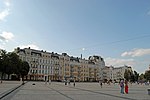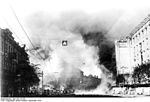State Migration Service (Ukraine)
2010 establishments in UkraineGovernment agencies established in 2010Government agency stubsImmigration servicesImmigration to Ukraine ... and 2 more
Ministry of Internal Affairs (Ukraine)Ukraine stubs

The State Migration Service of Ukraine (SMS) is a government agency of Ukraine that administers policy in the areas of immigration (both legal and illegal), emigration, and citizenship, as well as the resident registration (uk) system. It is part of the Ministry of Internal Affairs of Ukraine and was established in 2010.
Excerpt from the Wikipedia article State Migration Service (Ukraine) (License: CC BY-SA 3.0, Authors, Images).State Migration Service (Ukraine)
Volodymyrska Street, Kyiv Центр
Geographical coordinates (GPS) Address Nearby Places Show on map
Geographical coordinates (GPS)
| Latitude | Longitude |
|---|---|
| N 50.456244 ° | E 30.5178194 ° |
Address
Volodymyrska Street 9
01025 Kyiv, Центр
Ukraine
Open on Google Maps










